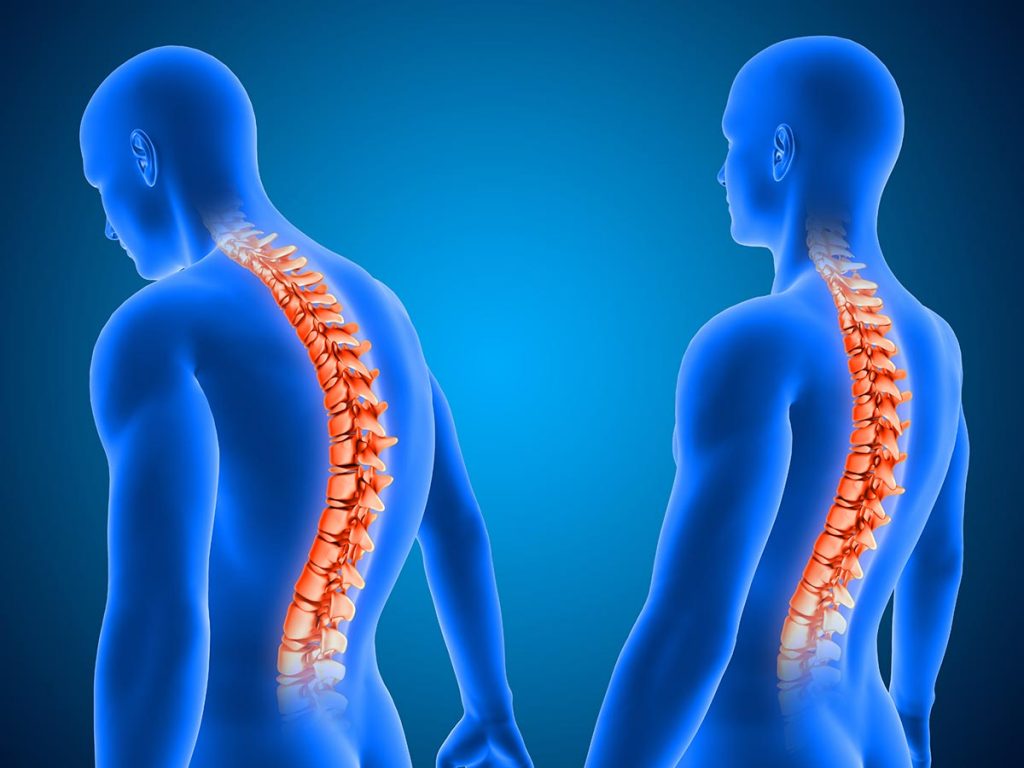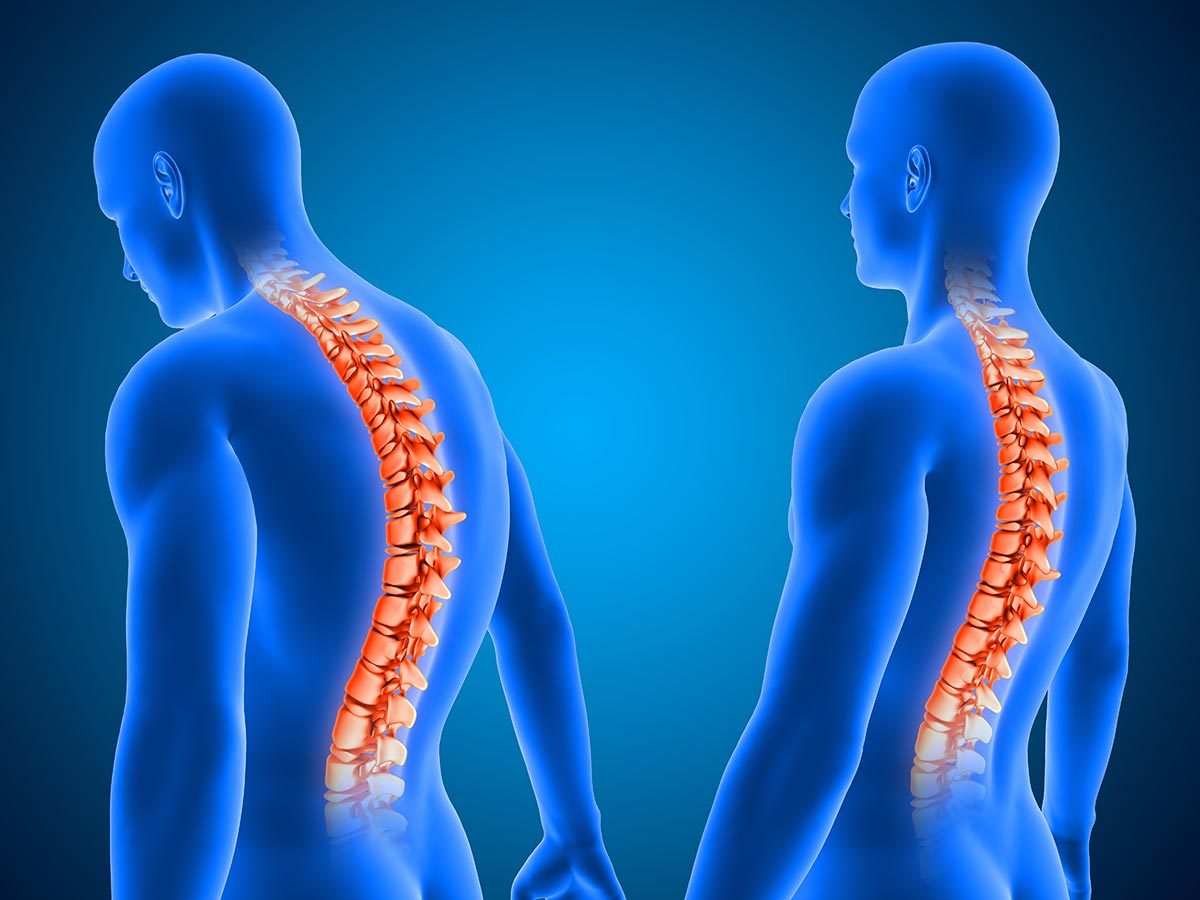Scheuermann’s Disease (Kyphosis)
![]()
Call (703) 520-1031 or use the form below to send us your contacts.
Kyphosis is a forward rounding of the back and is a spinal disease that can occur at any age. Scheuermann’s disease specifically refers to kyphosis that develops in children and adolescents and results in an exaggerated curvature of the spine. Named after the Danish orthopedic surgeon Holger Scheuermann, the spinal disease is often treatable.

What is Scheuermann’s Disease?
Scheuermann’s disease is a skeletal disease in which the spine develops an accentuated curve outward. There are three major spine sections called a cervical (neck), thoracic (upper and middle back) and lumbar (lower back).
The cervical and lumbar sections have a C-shaped curve with the middle section of the C curving towards the body. The thoracic section has a reverse C-shaped curve with the middle of the C curving outward or away from the body. The normal curves in the spine play an important role in balancing body weight and enabling movement.
Scheuermann’s disease is also called Scheuermann’s kyphosis or juvenile kyphosis. (Note: Sometimes pronounced by Americans as Sherman disease of the spine.) It typically occurs in children and adolescents while still growing.
The spine is made up of bones called vertebrae that are stacked in a long column. There are cushioning intervertebral discs between the bones that act like shock absorbers. When the vertebrae in the spine grow abnormally or abnormal vertebrae develop for any reason, the spine’s normal curve can become misshapen. Scheuermann’s disease usually develops in the upper spine but can occur in the lumbar or lower spine.
Symptoms
Scheuermann’s disease is frequently first noticed when a child develops a hunched posture. Typical Scheuermann’s disease symptoms include:
- The exaggerated forward curve in the thoracic spine, creating a humpback appearance
- Back pain, especially during long periods of inactivity or excessive exertion
- Movement limitations
- Muscle cramps or spasms
- Complications that include breathing and digestive problems
Approximately half of the children with Scheuermann’s kyphosis experience pain. When a child complains of back pain, the spine pain in the child may be a symptom of Scheuermann’s disease.
As mentioned, this condition usually develops in the thoracic spine, but it sometimes develops in the lumbar spine. Scheuermann’s disease in the lumbar spine may be more painful than kyphosis in the thoracic spine.
Causes
The basic cause of Scheuermann’s disease is abnormal bone growth. As a child or adolescent grows in spurts, some parts of the vertebrae grow at different rates. Several vertebrae develop a wedged shape, which causes the spinal column to lean forward, creating an abnormal curve in the back.
Though not known for certain, the abnormal bone growth is believed to be due to interruptions in the flow of blood to vertebrae during bone growth. The result is the front of the vertebrae grows faster than the back of the vertebrae, leading to a wedge shape instead of a rectangular shape. Researchers have also identified a hereditary component, but the genetic transmission remains unclear.
Boys develop Scheuermann’s Disease more often than girls at a rate of 2:1. Though due to abnormal growth, it is also known to occur with certain syndromes like Marfan Syndrome and Ehlers-Danlos Syndrome. Both syndromes are genetic disorders of connective tissues.
Diagnosis
Diagnosis is rarely made before a child turns ten years old. A physician will first conduct a physical examination, looking for outward signs of the spinal curve and also checking for muscle strength and the spinal range of motion.
The physician will then decide which of the following tests to order:
- X-rays determines the degree of curvature and identifies vertebrae deformities
- Myelography – x-ray using specialized dye to identify spine abnormalities
- CT scan – computerized axial tomography scan (CAT scan) that combines a series of x-rays to determine the degree of curvature and vertebral deformities in greater detail
- MRI – magnetic resonance imaging creates detailed images of tissues and organs to detect anomalies like a tumor or infection
If there are three or more vertebrae that have a wedge shape of five degrees or more, or a spinal curvature of 45 degrees or more, a diagnosis of Scheuermann’s disease is likely.
Treatments
Sometimes, Scheuermann’s disease is not detected early because a curved back in the child is attributed to poor posture. However, when the disease is confirmed during childhood or adolescence, the following Scheuermann’s disease treatments are available.
- Physical therapy
If the skeleton is still growing, physical therapy may help correct a high percentage of the deformity. The physical therapy can strengthen the muscles supporting the spine and increase blood flow.
- Limit activities to low-impact exercises and stretching
It is important for the child or teenager to avoid exercises or sports activities that stress the spine. Instead, doing low-impact exercises like swimming and cycling is recommended.
- Bracing
If more extensive treatment is needed, wearing a brace for 12-24 months might help. The effectiveness of bracing varies. There are three main types of bracing called the Milwaukee Brace, the Kyphologic Brace and the Thoracolumbosacral orthosis-style Boston Brace. All of the braces are shaped to the contours of the patient’s body and help the spine grow straight.
- Surgery
Though a possible treatment, it is not usually recommended for young patients. Surgery is used to treat kyphosis that is more than 75 degrees and causing severe deformity and pain.
Early Identification is Ideal
The earlier Scheuermann’s disease is diagnosed, the better. The majority of patients respond to conservative treatments. Scheuermann’s disease pain usually improves once the spine is fully developed.
